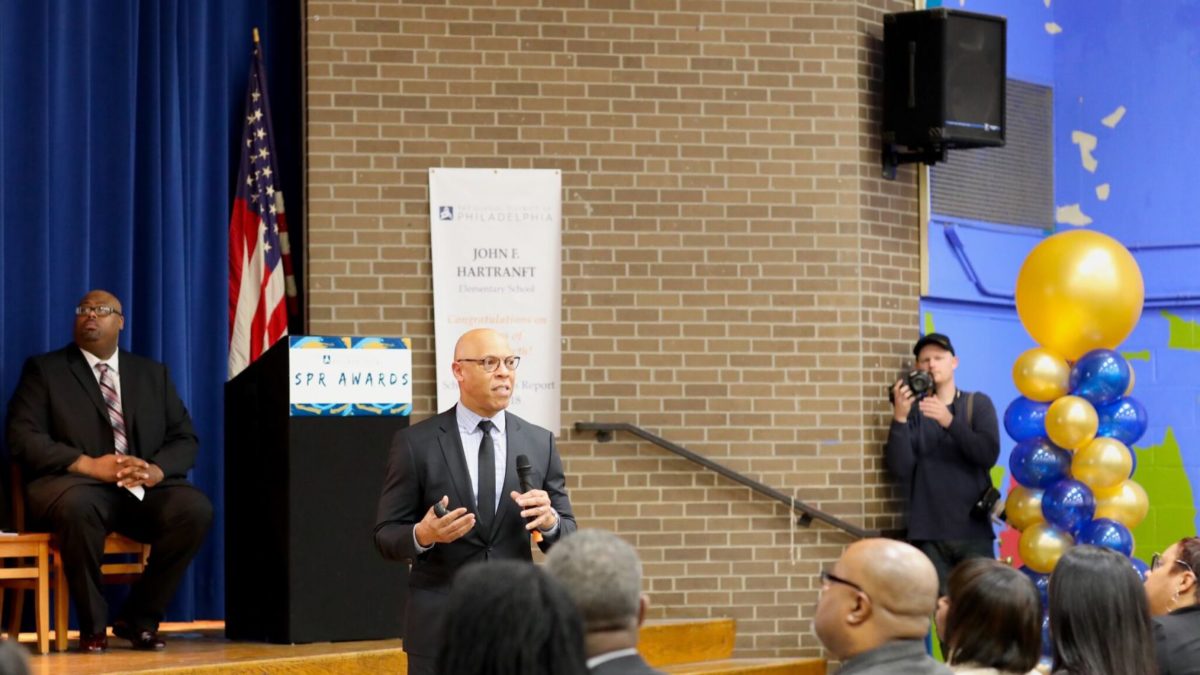Alexander Nieto-Perez remembers the time he started coming to South Philly’s Vare-Washington Elementary School as a pre-K student, and says there’s a whole lot more going on at the school now.
As a 12-year-old in seventh grade, Alexander says his school is a lot more than just a place that teaches you how to pass standardized tests.
“When I was in first grade there wasn’t a lot going on,” he said, sitting in the school library alongside two classmates, two teachers, and the school’s new principal, Gretchen Stewart. “Now there’s a lot of after-school activities. It used to be that you just came to school, learned, and just left.”
He says English and Language Arts are his favorite subjects but also said he has applied new skills in math while learning about taxation. “We actually present in front of a board,” he said. “This school is preparing us for not just this year but years after.”
Alexander’s appreciation for his school offers a glimpse of how the School District of Philadelphia is striving to turn its back on the financial distress, low academic performance and shaky morale that tormented it within only the last decade.
The district’s latest score in its annual School Progress Report – its benchmark for overall performance – rose for the third consecutive year to 42 percent in 2017-18 from 33 percent in 2014-15, indicating improvement in three key categories: student achievement and progress, college and career readiness, and school “climate,” a measure that includes attendance and parental involvement.
In all, 33 of 214 district-run public schools increased their scores for the third year in a row, while 11 rose two tiers in the SPR assessment. Another 86 independently-run public charter schools were also covered by the report.
“The data from our SPR reports confirm what we have known for some time – that our schools across the city are improving in the areas that matter most to student success,” PSD superintendent Dr. William Hite, said via statement.
Other district-wide data, though indicating improvement, show it still has much work to do. The report showed, for example, that only 46 percent of students are attending 95 percent or more of school days, and only 69 percent of students in district-led and alternative schools are graduating.
Still, the latest gains suggest the District is continuing to emerge from those dark days of 2013 when it closed 23 underutilized schools – about 10 percent of its total – to erase a projected $1.35 billion budget deficit over five years after a cut of more than $400 million in state funding.
Since then, the PSDs finances have improved thanks to more stable state funding and the transfer in 2018 of district governance to a city-run board from the state-run School Reform Commission, which oversaw the PSD starting in the early 2000s.
The brighter financial outlook was underlined last December by the credit-rating agency Moody’s Investor Services which increased the PSDs underlying bond rating by two notches to its first investment-grade level since 1977.
Moody’s attributed the upgrade to three consecutive years of budget surpluses and the commitment of permanent tax revenues from the City of Philadelphia after the return to local control, largely eliminating previously anticipated annual deficits in the near term.
“The District’s governance is now more closely tied to that of the city given the return to local control, and we anticipate a better alignment of city and school district interests as a result,” the agency said, while warning that any change in the City’s new commitment to the school district could contribute to another downgrade.
The upgrade, following another by Moody’s in 2017, will mean the district has to pay less to borrow money, freeing up millions of dollars for future investment, its chief financial officer, Uri Monson, said at the time.
The better financial stability has led to the restoration of previously cut positions like nurses and school counselors; allowed the purchase of new equipment such as classroom “smart boards” and has paid for student travel on a scale that would not have been possible when the budget crisis was at its height.
At George Washington Carver Engineering and Science School in North Philly, the PSD paid nearly $10,000 for a group of students to attend the national stage of an underwater robotics competition in New Orleans three years ago. The money wasn’t in the school’s budget, said Principal Ted Domers, but the district found it.
“I called Dr. Hite and said ‘Can you help me out with this?’ Not a problem,” said Domers, who has been principal at the school for five years. “When I first arrived as principal, we were sitting in August with Dr. Hite in meetings saying, ‘We’re going to make sure we don’t cut any more.’ There was just a lot of turmoil around it. There’s none of that any more.”
The greater stability has allowed Carver to expand its offerings to students, and to encourage them to pursue their interests in a way that would have been less likely in an atmosphere of perpetual financial crisis, Domers said.
“We know now that there’s stability within the District, and that is what Dr. Hite has brought, and has allowed us to grow,” he said. “If we’re constantly feeling overwhelmed with things being thrown at us then we’re just sitting here being reactive.”
Current innovations include collaboration with Mighty Writers, a local nonprofit that uses volunteers to teach clear writing skills to students at several locations, and is working with Carver to create a full-service writing center at the school.
Such outside groups won’t set up programs with any schools that are financially or even physically unstable, Domers said. “Their concern was: ‘We can’t be in a place where two years from now you tell us the walls are falling down,’” he said.
With greater financial stability, schools can focus on improving the performance measured by the annual School Progress Report.
In the 2017-18 school year, Vare-Washington increased its overall SPR score to 63 percent from 57 percent in 2016-17. It also improved its “progress” score – measuring growth in standardized assessments – to 88 percent from 83 percent.
Its “achievement” measure of performance in standardized tests such as PSSAs also rose but only to 30 percent, putting the school in the district’s “watch” category.
While the school’s achievement indicators on reading, math and science all rose in 2017-18, they still showed that at least half of the school’s 369 students failed to reach proficiency in those subjects. In English language arts, for example, only 47 percent reached proficient or advanced level, while for math/algebra, just 34 percent attained that level.
The exception to the improving trend at Vare-Washington – where 100 percent of the students are classed as economically disadvantaged, and 32 percent are English language learners – was the “climate” measure which dropped four points to 64 percent, largely reflecting continuing problems with attendance, Stewart said. Only 57 percent of students attended 95 percent or more of instructional days in 2017-18.
“When I look at the SPR, one of the biggest things for me to respond to is getting kids here more often, and that is the drum I’ve been beating all year,” she said.
One answer has been to incentivize students to come to school with promises of out-of-school trips and to hold competitions between classes for the best attendance record.
Stephanie Pantoja-Perez, another seventh-grader, said she’s looking forward to her class visiting Rolling Thunder Skating Center, a roller-skating rink in Northeast Philadelphia, where the school is taking Stephanie’s class in recognition of its good attendance record.
“This year, as a prize of coming to school every day, we have the opportunity to go,” said Stephanie, 13. “We couldn’t be late more than two times over a 30-day period. If you missed two days, you couldn’t go to the Rolling Thunder but if you missed one day you still had the opportunity to go.”
Nihayah Laws, 12, said her class is getting a pizza party at the end of the month as a prize for having the best attendance in the school – a 100 percent record.
At the academically selective Carver school for middle and high school students, performance scores are also rising but from a higher base than at Vare-Washington. Carver’s overall score jumped 31 points to 85 percent in 2017-18 while student achievement rose to 73 percent and climate was little changed at 96 percent.
Thiyazan Salman, 17, a senior, said there are more after-school activities now than there were when he joined in ninth grade, and he enjoys the school’s stimulating atmosphere.
“Everything felt slow then,” he said, referring to his freshman year. “Now almost every week there’s something going on.”
“I come here because I enjoy being here,” Thiyazan said. “I’m a senior now and I’m going to have to leave soon and it kind of makes me sad but it also makes me happy because someone is going to fill my spot and hopefully experience all that I experienced, and possibly more.”
Amanda Frazer, 18, who expects to study economics or finance at Wellesley College when she leaves Carver, said there are more opportunities for students to pursue their interests there than when she started as a freshman. “If you want something to happen, go act,” she said. “There’s a very open community here.”
From the independent perspective of an education expert, too, Philadelphia’s public schools are turning themselves around.
Ray Hart, director of research at the Council of the Great City Schools, said Philadelphia is making progress on measures such as key academic performance indicators, suspension rates, and days of school missed.
Philly’s performance is helped by its efforts to reduce suspensions, driven by its “trauma-informed care” policy that recognizes the challenging circumstances faced by many students in America’s poorest big city, and tries to avoid suspensions for bad behavior like classroom outbursts, said Hart, whose organization represents 74 of the nation’s largest urban school systems.
“Our data shows that Philadelphia is making dramatic improvements in reducing suspension rates and keeping kids in school,” he said.
The improvements have a lot to do with the stability of its leadership, particularly since it has had the same superintendent, Dr. Hite, since 2012, Hart said.
“Keeping leadership consistent – that’s where you really begin to see districts turn the corner and make improvements that are tangible,” Hart said.
Principals and faculty interviewed for this story said they work toward goals set by the district in its Action Plan 3.0 framework for rebuilding district, and determine for themselves how to achieve them. At Vare-Washington, for example, teachers in the upper grades now focus on just two subjects rather than the full curriculum, allowing them to develop more expertise in how to teach their chosen subjects.
Lisa DiStefano, a sixth-grade teacher who has been with the district for 31 years, said she welcomes being able to focus on math and social studies. And she said it now feels like there’s more money for after-school activities.
“When I first came to the district, there was plenty of that stuff, then it stopped and was bone dry, and now it seems like it’s more,” she said.
Jenna Beck, an English teacher at Vare-Washington for the last five years, said she has no complaints about funding or policy. “I feel like I have been given everything that I need in the classroom to be successful. I haven’t had a principal tell me ‘no, we don’t have money for that.’”
While Vare-Washington’s SPR scores show it still has work to do in many areas, Principal Stewart defended the school as well-funded community where classes are small and teachers know and care for their students.
Asked what she would say to parents who are considering moving out of the city in search of what’s believed to be better suburban schools, Stewart said Vare-Washington serves all of its students in a way that any parent would want.
“It feels like, if we can dream it, we can do it,” she said.
TWITTER: @JONAHURDLE




